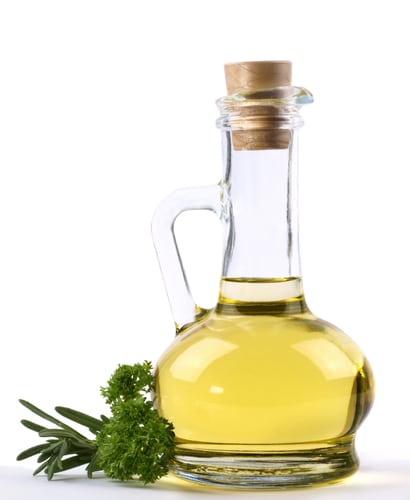
Some of the healthiest oils are those rich in omega-3 fatty acids, including canola oil, flaxseed oil, and walnut oil, although some people avoid canola oil because it may contain small quantities of trans-fat. Oils that are rich in monounsaturated fats are also healthy options because they raise HDL-cholesterol, the form that’s linked with a lower risk for heart disease. Canola and olive oil are both good sources of monounsaturated fat.
How Vegetable Oil is Extracted and Processed
Vegetable oils are extracted from the oily components of plants, usually the seeds. This is done in one of two ways – through mechanical extraction or with the help of solvents. Mechanical extraction is the better method because when oils are extracted using solvents it destroys some of their nutritional benefits. Plus, the solvents used to extract the oil comes from hexane, a petroleum product, not something you want even traces of in your body.
There are two main ways oils are extracted mechanically. One method called expeller pressing uses high pressure to remove the oils. Although this method is chemical-free, it exposes the seeds and oil to high heat. This destroys some of its nutritional value. Harder seeds require more pressure and generate more heat during the extraction process. The other way oils are extracted from plants is by cold pressing. With cold pressing, the seeds and oil are exposed to temperatures no greater than 120 degrees Fahrenheit.
Extra-virgin olive oil is cold-pressed. This gives it a lower level of acidity and a more appealing flavor. Since olive oil is a good source of antioxidant polyphenols, vitamin E and heart-healthy fats, it’s important to preserve these nutrients as much as possible by minimizing the amount of heat the oil and seed are exposed to. That’s why cold-pressed extra-virgin olive oil is a good choice. Virgin olive oil is also cold-pressed but comes from the second pressing. It has a higher level of acidity than extra-virgin olive oil. When you see “pure olive oil” on a label, it means the oil has been exposed to solvents and has been refined. The advantage is you can heat refined olive oil to higher temperatures.
Refined Vegetable Oil versus Unrefined Oils
Many of the vegetable oils you buy in the supermarket are refined – to raise the smoke point for high-temperature cooking and to give them a longer shelf life. The downside is refined oils are less nutritious and flavorful. Fortunately, you can buy unrefined vegetable oil at most health food stores and natural food markets. They’re ideal for making salad dressings and sauces where you won’t be heating the oil.
How to Preserve the Health Benefits of Vegetable Oil
For low-temperature applications, cold-pressed extra-virgin olive oil and unrefined oils rich in omega-3s and monounsaturates are among the healthiest and most flavorful options. To preserve their health benefits, keep these oils in a cool place where they aren’t exposed to light. They should be stored in a dark bottle to protect their flavor and nutrients. Refined oils can be stored for as long as a year, but unrefined oils have a shelf-life of only about six months.
The Bottom Line?
Unrefined vegetable oil retains more of their flavor and nutritional value, but it shouldn’t be exposed to high heat. Cold-pressed olive oil can be heated to low temperatures but should be kept below 200 degrees Fahrenheit. For higher heat cooking, grapeseed oil, avocado oil or organic, expeller-pressed canola oil are good options since they contain significant amounts of monounsaturated fats.
Fats and oils in reasonable quantities are an important part of any diet – to add flavor and to supply the essential fatty acids your body needs for health – but choose them wisely.
References:
Olive Oil Source. “Chemical Characteristics”
Nutrition Research Reviews 18, 98–112 (2005)
National Cooperative Grocers Association. (2010) “All About Oils”
Related Articles By Cathe:
The Healthy Cooking Oil You Probably Aren’t Using
Good Fats Versus Bad Fats: The Problem With Vegetable Oils
Vegetable Oils: Why They’re Not as Healthy as You Think
3 Ways an Omega-6 to Omega-3 Imbalance Causes Inflammation and Disease
Extra-Virgin Olive Oil is Healthy, but is It Safe to Cook With?

